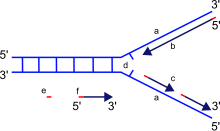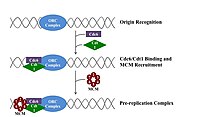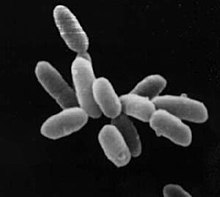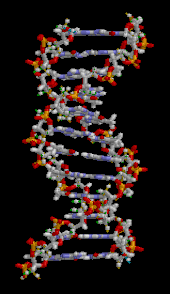DNA is also called to be the deoxyribose nucleic acid that has many genetic data in it and vital for synthesis. DNA polymerases isolated from cells and artificial DNA primers can be used to start DNA synthesis at known sequences in a template DNA molecule.
With concern to the question for is DNA replication bidirectional, it is bidirectional and none of the two finishes shall be still and both shall move. Thus, it has replicating of the leading and lagging strand. Bidirectional replication is the process of the replication of the DNA seen in all the vital kingdoms.
The cells of every organism have molecules that stores the genetic data which is responsible for the function and growth of any organism on the planet. Thus the molecule of DNA stress the information that needs to be passed and with the concern for is DNA replication bidirectional is true. It includes having the DNA replicated in two ways at the similar time that results in the faster replication in leading one.

There are always their major formation of the DNA and all of them are double stranded and inked by having its connection with the complementary base pairs. They are called the A form, B form and Z form also being bidirectional and with the concern for is DNA replication bidirectional is true slow in lagging and with the concern for is DNA replication bidirectional is true.
Why is DNA replication bidirectional?
There are always two ways of having the process of replication done which are unidirectional and bidirectional. They are seen in the nucleus with one of the good trait being much bigger in its size than the prokaryotes with having much vitality.
In terms of the DNA both the ends of the DNA strands shall be kept moving with no force from in or out to make it stop with having replication done from both the ends and with the concern for is DNA replication bidirectional is true. Thus with the concern for is DNA replication bidirectional is true.
With the concern for is DNA replication bidirectional being true, it is also true that the process is said to be discontinuous. At the place of the start for replication there is a formation of two of the replication forks that extend in two directions. On the part of the lagging strands. The Okazaki fragments are made in a manner that is discontinuous. This was proved be David Prescott with the start of the replication for DNA begging at lots origin.

It deals with the process where there is replication seen in between the media storage like that of the hard disk or any virtual disk in several locations where data gets converted in any way. In the bidirectional path, the source and the final place of the media can be made to interchange and with the concern for is DNA replication bidirectional is true and after some times the double helix seem to unwind.
Is DNA replication bidirectional in eukaryotes?
DNA is a material found in all the living beings which may be either unicellular or multicellular or eukaryote or prokaryotes. The eukaryotes have linear DNA and the site for having the process of DNA replicated is many with the prokaryotes having a DNA that is circular.
The shape and method of DNA replication differs but has its presence in all and with the concern for is DNA replication bidirectional is true. Thus, all the eukaryotes have linear DNA and thus the process of having its DNA replicated is bidirectional and then gets replicated in two of the sides much far than the origin and then makes two of the replicating forks at both ends.

Eukaryotes are the organism that have many cell and the cell do have a nuclei and also other organelles having a member to cover itself. There are much range in this category which consist of the fungi, protists, the animals, plants and also most of the algae seen. They can be either multicellular or one celled and with the concern for is DNA replication bidirectional is true.
In the cells of prokaryotes, there is only a single point for having its origin replicated this the methods takes place in both ways but in directions that are opposite to each other and is seen in the cytoplasm of the cell. Eukaryotes have this method done in the nucleus of cell having many point of origin and with the concern for is DNA replication bidirectional is true.
Is DNA replication bidirectional in prokaryotes?
The replication of DNA in the prokaryotes be it the bacteria or the archaea is said to have one space for replication only. There is as it is no much difference seen in the process of having the DNA replicated in the two very different organism being eukaryotes and prokaryotes.
The process of replication in the prokaryotes is said to be bidirectional and with the concern for is DNA replication bidirectional is true. This process inside it has three of the steps included being the initiation, the elongation and the termination. Just that the eukaryotes have many site for replication. The eukaryotes have linear DNA and the site for having the process of DNA replicated is many.

The process of replication for DNA in both the eukaryotes and prokaryotes is said to be bidirectional with these having DNA that is circular in form an also has only one place of getting itself replicated while the once in the eukaryotes having linear DNA have many series for DNA replication making it bidirectional while prokaryotes have one but both being bidirectional and with the concern for is DNA replication bidirectional is true.
Is bacterial DNA replication bidirectional?
As discussed earlier, the process of DNA replication is same in both the types of organism be in with many cells or one cell. The accuracy of the DNA getting copied in the double helical formation is vital for getting the traits inherited.
Bacteria are termed to be the wide classified group of the prokaryotes and with the concern for is DNA replication bidirectional is true. It takes place in both ways in most of the bacteria with having proteins as well and with the concern for is DNA replication bidirectional is true and to define the cells of the phenotype and from the organism as well.
Here are two of the replicating forms made in the opening strands of the double stranded DNA that originates and also the enzyme called helicases can separate the two of the DNA strands that can be coated by any of the proteins that binds and the also single stranded keeping both of the strands separated proving with the concern for is DNA replication bidirectional is true. The basic machines needed to have the DNA copied in kept in all different forms being it bacteria or the eukaryotes or archaea.

Is DNA replication always bidirectional?
DNA replication is bidirectional from the origin of replication. To begin DNA replication, unwinding enzymes called DNA helicases cause short segments. DNA replication occurs during the S-stage of interphase.
DNA is made of the monomer nucleotides. Each nucleotide has a sugar, a phosphate group and a base. The orientation of the nucleotides gives directionality to the DNA based on which way the carbons in the sugar are oriented, either 5′ to 3′ or 3′ to 5′. This shows the fact with the concern for is DNA replication bidirectional being true.
DNA is made up of a double helix of two complementary strands. The double helix describes the appearance of a double-stranded DNA which is thus composed of two linear strands that run opposite to each other and twist together to form. During replication, these strands are separated forming forks at both end with the concern for is DNA replication bidirectional is true.

Each strand of the original DNA molecule then serves as a template for the production of its counterpart, a process referred to as semiconservative replication. As a result of semi-conservative replication, the new helix will be composed of an original DNA strand as well as a newly synthesized strand. Cellular proofreading and error-checking mechanisms ensure near perfect fidelity for DNA replication.
Polymerase chain reaction said to be PCR, ligase chain reaction also called LCR, and transcription-mediated amplification or TMA are examples.
Why does DNA replication occur in the 5 to 3 direction?
DNA replication occurs in the 5′ to 3′ direction. DNA polymerase can only add nucleotides to the 3′ OH group of the growing DNA strand, this is why DNA replication occurs only in the 5′ to 3′ direction.
DNA polymerase can therefore only add nucleotides to the growing chain and cannot initiate the replication. even in bacteria, with their smaller genomes, DNA replication involves an incredibly sophisticated, highly coordinated series of molecular events. These events are divided into four major stages: initiation, unwinding, primer synthesis, and elongation.
During initiation, so-called initiator proteins bind to the replication origin, a base-pair sequence of nucleotides known as oriC. This binding triggers events that unwind the DNA double helix into two single-stranded DNA molecules. Several groups of proteins are involved in this unwinding and dealing with the concern for is DNA replication bidirectional is true.
The DNA helicases are responsible for breaking the hydrogen bonds that join the complementary nucleotide bases to each other; these hydrogen bonds are an essential feature of James Watson and Francis Crick’s three-dimensional DNA model. Because the newly unwound single strands have a tendency to rejoin, another group of proteins, the single-strand-binding proteins.

Can DNA replication be unidirectional?
As in prokaryotes, the linear chromosomes of eukaryotes replicate by strand separation and complementary base pairing of free deoxyribonucleotides with those on each parent DNA strand
Unidirectional DNA synthesis is only seen in a few prokaryotes whereas bidirectional DNA replication occurs in all eukaryotes and many prokaryotes. In unidirectional synthesis, the replication process occurs in only one direction. In bidirectional synthesis, the replication process occurs in two directions. Plasmids that replicate by this mechanism are sometimes called RC plasmids.
A type of DNA replication where replication is moving along in both directions from the starting point. This creates two replication forks, moving in opposite directions. Directionality has consequences in DNA synthesis, because DNA polymerase can synthesize DNA in only one direction by adding nucleotides to the 3′ end of a DNA strand making is DNA replication bidirectional true making is DNA replication bidirectional true.

The nucleic acid sequences are complementary and parallel, but they go in opposite directions, hence the antiparallel designation. The antiparallel structure of DNA is important in DNA replication because it replicates the leading strand one way and the lagging strand the other way. An RNA primer complementary to the parental strand is synthesized by RNA primase and is elongated by DNA polymerase III through the addition of nucleotides to the 3′-OH end. There is also a method called the replication of theta and is a unidirectional matter.
Conclusion
To wrap up the post, we can say that with concern to the question of is DNA replication bidirectional is a true fact with all the eukaryotes an prokaryotes having the similar pattern for replication of DNA. The eukaryotes have a many site for replication and the prokaryotes have only one and this is a vital difference with both being bidirectional.
Also Read:
- Is cell membrane rigid
- Do mitochondria have enzymes
- Springtail characteristics
- Holoenzyme and enzyme
- Does fermentation occur in the mitochondria
- Are bacteria biotic or abiotic
- Gravitropism plant example
- Carbohydrates structure examples
- Are algae protists
- Intracellular bacteria examples
I am Ankita Chattopadhyay from Kharagpur. I have completed my B. Tech in Biotechnology from Amity University Kolkata. I am a Subject Matter Expert in Biotechnology. I have been keen in writing articles and also interested in Literature with having my writing published in a Biotech website and a book respectively. Along with these, I am also a Hodophile, a Cinephile and a foodie.

Hi Fellow Reader,
We're a small team at Techiescience, working hard among the big players. If you like what you see, please share our content on social media. Your support makes a big difference. Thank you!